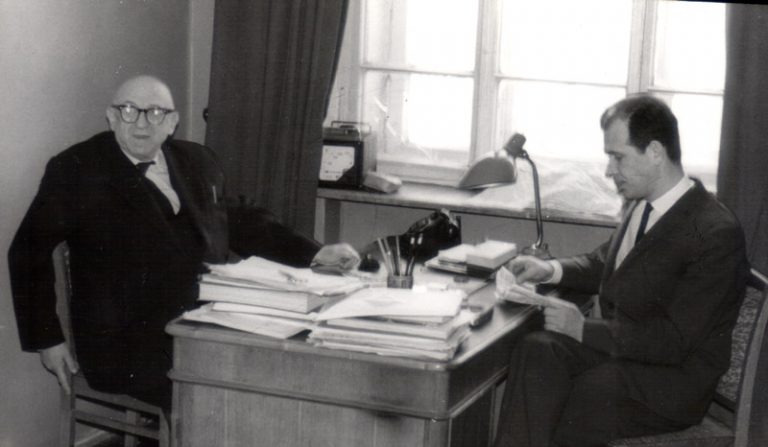
Д.ф.-м.н., профессор Шпольский Эдуард Владимирович
Заведовал кафедрой теоретической физики с 1939 г. по 1972 г.
Заслуженный деятель науки РСФСР, лауреат государственной премии СССР, ордена Ленина (1953), золотой медали им. С.И.Вавилова АН СССР (1962), ордена Трудового Красного Знамени (1972). Автор открытия уникального физического эффекта, автор фундаментального двухтомника «Атомная физика». Главный редактор журналов «Успехи физических наук» и «Физика».
Кафедра теоретической физики
основана в 1939 году. Проблемная лаборатория спектроскопии сложных органических соединений появилась в составе кафедры в 1967 году благодаря Э.В. Шпольскому и его открытию. При слиянии в 1960 году МГПИ им. В.И. Ленина и Московского городского педагогического института им. В.П. Потемкина в университете образовались сразу две кафедры теоретической физики, на которых работали широко известные учёные – Э.В. Шпольский и Г.М. Бартенев. Тематики работ были различные. Под руководством Г.М. Бартенева велись научные работы по экспериментальному исследованию механических, диэлектрических, фрикционных, реологических свойств полимеров и неорганических стекол. Характерной особенностью работ была тесная связь с отраслевыми институтами, для которых разрабатывали и фундаментальную составляющую, и конкретную методику измерений. Было создано конструкторское бюро, благодаря которому ряд отраслевых институтов получили возможность работать на растиражированных и достаточно дешевых приборах. Под руководством Э.В. Шпольского был открыт эффект возникновения тонкоструктурных квазилинейчатых спектров в замороженных растворах сложных органических веществ (эффект Шпольского). Открытие отмечено Государственной премией СССР и послужило основой научного направления селективной спектроскопии примесных органических соединений. В те годы было принято решение не объединять кафедры, а оставить одну кафедрой теоретической физики, а другую назвать кафедрой физики твёрдого тела. С 2014 года кафедра стала объединенной, а 2015 году приказом ректора МПГУ кафедре было присвоено имя Э.В. Шпольского. Сотрудниками кафедры были выдающиеся отечественные ученые – физики: Г.С.Ландсберг, И.Е.Тамм, Е.М.Лифшиц, А.И.Наумов, Р.И.Персонов.





Роман Иванович Персонов
(04.01.1932 г. – 17.01.2002 г.) — советский и российский физик, спектроскопист, доктор физико-математических наук, профессор, один из основоположников селективной лазерной спектроскопии сложных молекул в растворах. Лауреат Государственной премии СССР (1985) и Премии А.Гумбольдта, Германия (1995). Приглашенный профессор нескольких зарубежных университетов. Автор более 150 науч-ных публикаций, обзоров и монографий.
Родился в Москве в семье писателя- драматурга. Окончил физический факультет Московского государственного педагогического института им. В. И. Ленина (1955). В 1959-1970 годах — сотрудник (ассистент, доцент) кафедры теоретической физики МГПИ, ведет преподавательскую деятельность и работает в лаборатории Э. В. Шпольского. С 1970 г. — заведующий лабораторией электронных спектров молекул Института спектроскопии АН CCCР и с 1983 г. заведующий отделом молекулярной спектроскопии ИСАН. Одновременно с 1970 г. профессор кафедры «Квантовая оптика» МФТИ. В разные годы приглашался для чтения лекций в Университет г.Бордо (1986, 1994, 1995), Университет Париж-юг XI (1993), Высшую нормальную школу в Кашане, Франция (1993), Калифорнийский университет в Риверсайде, США (1994), Университет г. Байройт (1995, 1996, 1997, 1998, 1999), Венский университет (1996, 2001), Марбургский университет (1996), Национальный университет Тайваня и Институт атомных и молекулярных наук Academia Sinica (1997)., Калифорнийский университет в Риверсайде, США (1994), Университет г. Байройт (1995, 1996, 1997, 1998, 1999), Венский университет (1996, 2001), Марбургский университет (1996), Национальный университет Тайваня и Институт атомных и молекулярных наук Academia Sinica (1997).
Персоновым с коллегами сделаны два крупных открытия в спектроскопии примесного центра – предложены метод селективного возбуждения тонкоструктурных спектров (метод Персонова, Fluorescence Line Narrowing, 1972) и метод выжигания стабильных спектральных провалов (Persistent Spectral Hole-Burning, 1974). Среди учеников Персонова 12 кандидатов и 5 докторов наук.
Осадько Игорь Сергеевич
(04.03.1938 г. ‒ 24.01.2020 г.) Советский и российский физик-теоретик, доктор физико-математических наук (1978), профессор. Получил почетное звание «Соросовский профессор» (1995-1996). Награжден премией РАН им. Д.С. Рождественского (2004) за цикл работ «Спектроскопия одиночных молекул и локальная динамика аморфных сред».
Получил почетное звание «Соросовский профессор» (1995-1996). Награжден премией РАН им. Д.С. Рождественского (2004) за цикл работ «Спектроскопия одиночных молекул и локальная динамика аморфных сред».
И.С. Осадько автор более 100 научных работ и монографий по различным направлениям оптики и спектроскопии конденсированных сред. Автор трех монографий, опубликованных издательством Физматлит: «Селективная спектроскопия одиночных молекул» (2000), «Флуктуирующая флуоресценция наночастиц» (2011), «Квантовая динамика молекул, взаимодействующих с фотонами, фононами и туннельными системами» (2017). В 2003 году была опубликована его книга «Selective spectroscopy of single molecules». В 1990-х гг. был приглашенным профессором в Stanford University, University of Pennsylvania, University of Wisconsin (США), Osaka University, University of Tokyo (Япония), University of Bordeaux (Франция), Cairo University (Египет), University of Groningen (Нидерланды).
Родился 4 марта 1938 г. в Москве. Окончил физический факультет МГУ в 1962 году. С 1962 по 1967 обучался в аспирантуре в Институте физики АН УССР (Киев). В 1969 году там же защитил диссертацию на соискание ученой степени кандидата физико-математических наук под руководством выдающегося советского физика А.С. Давыдова. В 1978 г. им была защищена докторская диссертация. С 1967 года по 1999 год работал в Московском педагогическом государственном институте им. В.И. Ленина (ныне МПГУ), занимая должности старшего инженера (1967-1969), заведующего теоретическим сектором (1969-1979), заведующего лабораторией (1979-1988), профессора физики (1988-1999) на кафедре теоретической физики. Под его руководством успешно защитились 13 кандидатов наук. С 1999 года по 2010 год И.С. Осадько работал ведущим научным сотрудником ФИАН им. П.Н. Лебедева РАН, а с 2010 года перешел на работу в Институт спектроскопии РАН, где работал главным научным сотрудником лаборатории электронных спектров молекул до конца своих дней.



